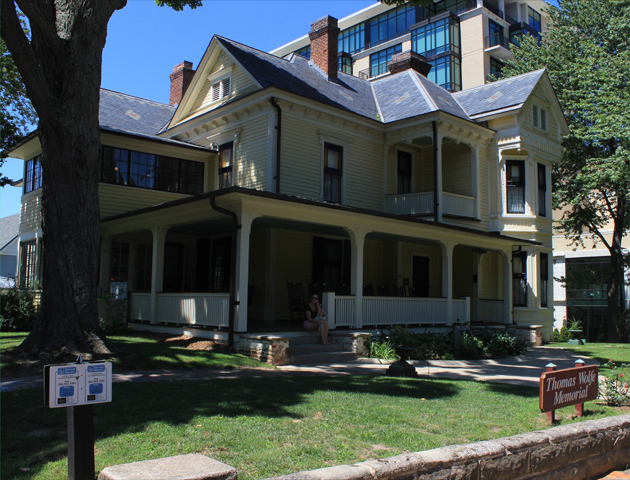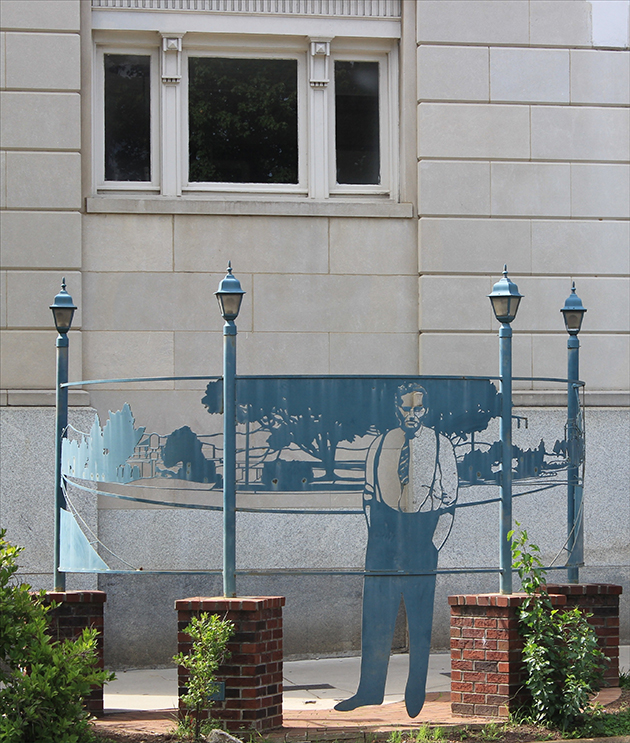Publisher's note: We believe the subject of history makes people (i.e., American people) smarter, so in our quest to educate others, we will provide excerpts from the North Carolina History Project, an online publication of the John Locke Foundation. This one hundred and seventeenth installment, by Jonathan Martin, is provided courtesy of the North Carolina History Project, and re-posted here with permission from NC Historic Sites.
The Cherokee were the first Native American residents of present-day Buncombe County, and German, Scottish, and English settlers inhabited the area in the early to mid-1700s. William Davidson and David Vance petitioned the North Carolina House of Commons in 1791 to establish a separate county out of Burke and Rutherford counties. The proposed name was Union, but it was switched to Buncombe County. Colonel Edward Buncombe was a Revolutionary soldier from Tyrell County who was captured during the Battle of Germantown. He died in May 1778 while on parole in Philadelphia, and the county is named in his honor.
Buncombe County was often referred to as the "State of Buncombe" because it encompassed such a large portion of western North Carolina. Its border touched Tennessee and South Carolina, and since its establishment ten districts have formed out of the county. At its present state, Buncombe County encompasses 646 square miles that contain the French Broad River; considered by some historians to be the third oldest river in the world, it flows from the south to north in Buncombe County. The Blue Ridge Mountains and the Great Craggy Mountains add to the county's elevated and natural landscape. A part of the Eastern Continental Divide also runs through the county.Asheville is the county seat of Buncombe, and it was established in 1797. Named after Governor Samuel Ashe (1795-1798), Asheville is the largest city in western North Carolina. Once a frontier post for Daniel Boone and Davy Crockett, the small town of Asheville and Buncombe experienced moderate economic growth. Although the Civil War hurt the region's economy, it was revitalized in 1880 with the arrival of the railroad. By 1890, the climate and countryside of Asheville attracted 30,000 seasonal residents every year, so several resorts and therapeutic lodges were built across the region.
 The Blue Ridge Parkway along the shoulders of the Craggy Mountains: Above. The Craggy Mountains in August: Below. photos by Stan Deatherage Click on images to expand.
The Blue Ridge Parkway along the shoulders of the Craggy Mountains: Above. The Craggy Mountains in August: Below. photos by Stan Deatherage Click on images to expand.

One of the greatest points of Asheville's history was the construction of the Biltmore Estate in the 1880s and 1890s. George W. Vanderbilt, heir to Cornelius Vanderbilt and his steamboat and railroad fortune, visited western North Carolina several times with his father. In 1889, Vanderbilt bought the city of Best near Asheville, renamed it Biltmore Village, and began plans to build a southern country home on the 125,000-acre property. Several world-renowned architects such as Richard M. Hunt and Frederick L. Olmstead were hired to plan the house blueprints and surrounding landscape, and the family celebrated their move-in of the 255-room house on Christmas Eve 1895. William Cecil, George Vanderbilt's grandson, still owns the house although the house is a National Landmark. The Biltmore Estate pays property taxes without government assistance, and approximately 750,000 tourists visit the Biltmore Estate annually.
 The Thomas Wolfe Memorial in downtown Asheville: Above. And around the corner a sculpture of the great writer - Thomas Wolfe: Below. photos by Stan Deatherage Click on images to expand.
The Thomas Wolfe Memorial in downtown Asheville: Above. And around the corner a sculpture of the great writer - Thomas Wolfe: Below. photos by Stan Deatherage Click on images to expand.

Two of North Carolina's most prominent governors as well as one of its most loved authors were natives of Buncombe County. David L. Swain (1801-1868) was governor of North Carolina from 1832 to 1835, and his reforms brought major changes to the state during the Convention of 1835. Zebulon B. Vance (1830-1894) was the governor of North Carolina during the Civil War. Vance was a well-known and respected politician, and he maintained citizen morale during the divisive war. Thomas Wolfe (1900-1938) wrote a series of novels that described North Carolina, and his greatest novel, Look Homeward, Angel (1929), is linked directly to his childhood in Asheville. Wolfe's novels have been heralded as "the closest approach to a North Carolina or an American epic that any writer has yet produced" (Ready, p. 361).
Asheville and the surrounding area are home to several historic and cultural sites, and the region hosts various festivals and events. Buncombe County not only encompasses the Biltmore House but also the Grove Park Inn and the Thomas Wolfe Memorial. Also, the University of North Carolina at Asheville, Warren Wilson College, and Montreat College are academic institutions within Buncombe County. The Swannanoa Music Festival, the Mountain Dance and Folk Festival, the Culturefest, the Poetry Festival, and the Sourwood Festival are annual events held in Buncombe.
Sources:
"Buncombe County." David Leroy Corbitt. The Formation of the North Carolina Counties, 1663 – 1943. (State Department of Archives and History, Raleigh, NC: 1950, 1969). p. 38-42.
"Ashville, Biltmore House, and Buncombe County." William S. Powell, ed. Encyclopedia of North Carolina (University of North Carolina Press: Chapel Hill, NC 2006), p. 67-68, 117-119, and 155.
North Carolina, 2nd Edition. Hugh T. Lefler and Patricia Stanford. (Harcourt Brace Jovanovich, Inc, New York: 1972). p. 218 and 279.
The Tar Heel State: A History of North Carolina. Milton Ready. (University of South Carolina Press: Columbia, SC 2005), p. 232-3 and 361.
"Synopsis I." A Brief History – Buncombe County, North Carolina. http://www.buncombecounty.org/About-BC/AboutBC/SynopsisI.aspx, (accessed July 28. 2011).
"Asheville History." Explore Asheville Website. http://www.exploreasheville.com/local-info/history/index.aspx, (accessed July 28, 2011).
"Thomas Wolfe Memorial: Biography of Thomas Wolfe." The North Carolina Department of Cultural Resources Website. http://www.nchistoricsites.org/wolfe/bio.htm, (accessed July 28, 2011).
By Jonathan Martin, North Carolina History Project




